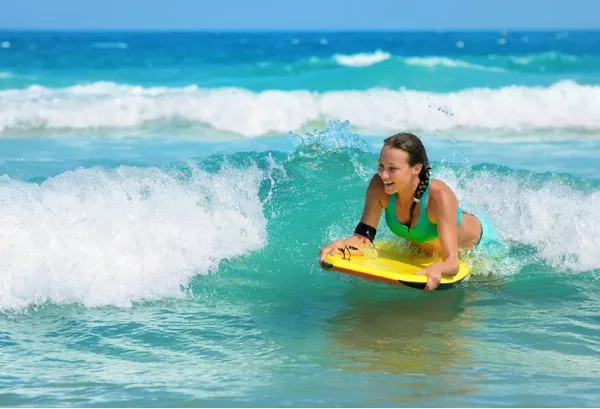Bodyboarding, often referred to as boogie boarding, is a thrilling water sport that combines the excitement of surfing with the ease of accessibility. Whether you’re a beginner seeking a new aquatic adventure or an experienced surfer looking to diversify your skills, mastering the art of bodyboarding can provide endless hours of enjoyment in the waves. In this comprehensive guide, we’ll delve into the essential techniques, equipment, and safety measures necessary to become proficient in bodyboarding.
Getting Started: Essential Equipment
Before hitting the waves, it’s crucial to equip yourself with the necessary gear to ensure a safe and enjoyable bodyboarding experience. The primary piece of equipment you’ll need is a bodyboard, also known as a boogie board. Bodyboards come in various shapes, sizes, and materials, catering to different riding styles and skill levels.
When selecting a bodyboard, consider factors such as length, width, thickness, and core material. Beginners may opt for a softer board with a larger surface area for increased stability, while more advanced riders might prefer a sleeker, high-performance board designed for speed and maneuverability.
Additionally, invest in a quality pair of swim fins to provide propulsion and control while navigating through the waves. Fins come in different styles, including full-foot and adjustable strap designs, so choose a pair that fits comfortably and securely.
Other essential equipment includes a leash to tether the bodyboard to your wrist, preventing it from drifting away in the surf, and a rash guard or wetsuit to protect against abrasions and maintain body temperature in cold water.
Mastering Basic Techniques: Riding the Waves
Once equipped with the necessary gear, it’s time to hit the water and start mastering basic bodyboarding techniques. Follow these steps to get started:
1. Paddling Out: Position yourself on the bodyboard with your chest centered on the board and your arms extended forward. Use your hands to paddle out past the breaking waves, employing a combination of arm strokes and kicking with your fins.
2. Catching Waves: As you spot an approaching wave, turn your body towards the shore and begin paddling towards it. Time your entry so that you catch the wave just as it begins to crest and break.
3. Take-off: As the wave lifts the back of the bodyboard, shift your weight forward and push yourself up onto your knees or belly. Keep your body centered on the board and maintain a low center of gravity for stability.
4. Trimming and Steering: Once riding the wave, use your arms and legs to adjust your position on the bodyboard, shifting your weight to control speed and direction. Lean into turns to carve through the face of the wave and maintain balance.
5. Exiting the Wave: As the wave begins to dissipate or close out, angle the bodyboard towards the shore and prepare to dismount. Gradually reduce speed by dragging your hands or kicking with your fins until coming to a stop in shallow water.
Advanced Techniques: Elevating Your Skills
As you gain confidence and proficiency in basic bodyboarding techniques, you may wish to challenge yourself with more advanced maneuvers and tricks. Here are some techniques to consider mastering:
1. Bottom Turns: Execute a bottom turn by leaning into the face of the wave and carving a sharp turn towards the breaking section. This maneuver allows you to generate speed and set up for more advanced maneuvers.
2. Top Turns and Cutbacks: After performing a bottom turn, transition into a top turn by driving the bodyboard up the face of the wave and redirecting back down towards the trough. Cutbacks involve carving a tight turn back towards the breaking wave, utilizing the wave’s energy to maintain momentum.
3. Aerial Maneuvers: Push the boundaries of bodyboarding by attempting aerial maneuvers such as spins, flips, and aerial rolls. These advanced tricks require precise timing, technique, and aerial awareness to execute successfully.
4. Tube Riding: Master the art of riding inside the barrel of a breaking wave, known as tube riding or getting barreled. Position yourself deep within the curl of the wave, maintaining speed and balance as you navigate through the hollow section.
5. Drop Knee Riding: Experiment with drop knee riding, a variation of bodyboarding where one knee remains on the board while the other foot hangs off the side. This stance offers increased control and maneuverability, particularly in larger waves.
Safety First: Minimizing Risks in the Water
While bodyboarding can be an exhilarating sport, it’s essential to prioritize safety and minimize risks while in the water. Follow these safety tips to ensure a safe and enjoyable bodyboarding experience:
1. Know Your Limits: Assess your skill level and only attempt maneuvers and waves within your capabilities. Progress gradually and seek guidance from experienced riders when trying new techniques.
2. Respect the Ocean: Familiarize yourself with local wave conditions, currents, and hazards before entering the water. Be mindful of rip currents, submerged rocks, and other potential dangers.
3. Use Proper Equipment: Ensure your bodyboard, fins, leash, and wetsuit are in good condition and appropriate for the wave conditions. Always wear a leash to prevent separation from your board in the surf.
4. Stay Hydrated and Energized: Bodyboarding can be physically demanding, so stay hydrated and fueled with snacks to maintain energy levels throughout your session. Take breaks as needed to rest and rehydrate.
5. Buddy System: Whenever possible, bodyboard with a friend or in the presence of other water enthusiasts. Keep an eye on each other and be prepared to assist in case of emergencies.
Conclusion
By following these guidelines and practicing regularly, you can enjoy the exhilaration of bodyboarding while minimizing risks and maximizing your skills. Whether carving through waves, launching aerial maneuvers, or simply cruising along the shoreline, bodyboarding offers endless opportunities for adventure and excitement on the water. So grab your board, dive in, and experience the thrill of mastering the art of bodyboarding.

